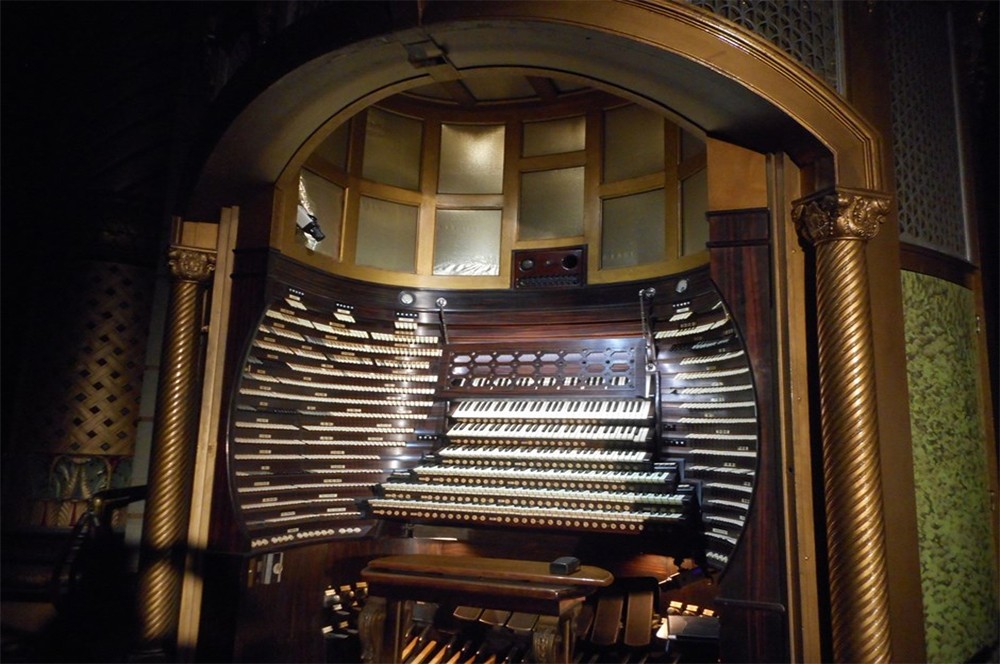A single tone is ringing out throughout the convention center. It’s so pure and constant that, as we ascend the escalators to the main hall, it’s not clear whether it’s just the building’s background hum, or perhaps a residual ringing in my ears. Suddenly it stops, then restarts at a slightly higher pitch. “Is that the organ?!” I ask our guide. Of course it is. The instrument, which is being readied for a recital the following morning, “almost constantly” needs tuning, he says, because of “ever-changing climates” inside the giant hall. When the doors swing open to the cavernous main auditorium, the background tone becomes a note that fills the air and the ears of everyone inside it.
Home of the Miss America pageant, and having also hosted everything from a Beatles concert to WrestleMania to the 1964 Democratic National Convention, the giant vaulted main hall of Boardwalk Hall in Atlantic City was, at the time of construction, the largest columnless arched interior space in the world — in 1970 the world’s first indoor helicopter flight took place here.
But the sound of that machine was nothing compared to Boardwalk Hall’s pièce de résistance: a gigantic pipe organ — the world’s largest instrument ever constructed. “We did at one point hold the title for the loudest musical instrument,” says the organ’s curator, Nathan Bryson, “but I believe there may be a big outdoor instrument in Germany that has surpassed us” — at 138.4 decibels, the record is about 100 times louder than a chainsaw. The most impressive thing? Only about one-third of the organ is currently playable. An ongoing $16 million renovation project aims to bring it back to its former glory.
"THE THING ABOUT PIPE ORGANS IS THAT EVERY INSTRUMENT IS UNIQUE."
The 85-year-old organ comprises 33,112 total pipes made variously from woods and metals. Pipe organs mimic the voices of an entire orchestra— a certain set of pipes might sound like a reed or flute section. We are brought into one of the organ’s eight chambers by tour guide Scott Banks, the outreach assistant for the Historic Organ Restoration Committee, where we weave between, duck under and climb around the spiderweb of fragile pipes. Many are made of soft metals like tin and lead — you can see footprints of contractors who damaged the organ during the building’s previous renovations, which, combined with existing flood damage from a hurricane in 1944, had rendered the instrument unusable by the turn of the millennium.
Banks radios the rest of the team not to play any of the pipes while we are inside — without ear protection, sound from the low-C Grand Ophicleide stop (the largest and loudest such pipe in the world) could cause us “physical pain and permanent hearing damage in a matter of seconds,” he says. Next on the tour is the beast’s giant engine, which makes as much racket as many of the organ pipes that it supplies with pressurized air.
Also impressive: the organ’s command console, which modestly sits on one side of the hall’s expansive stage. With myriad switches, buttons and knobs, seven manual keyboards and an eighth set of pedals operated with the feet, it’s more an orchestral cockpit than a seat of music-making. “The thing about pipe organs is that every instrument is unique,” says curator Bryson, but once an organist knows the basics, they can play each one.
Remarkably, even though the majority of the organ is still being restored, it can still be played with a full range of pitches and so holds regular recitals, but once the team can pull out all the stops (literally — the phrase is an allusion to organ stops, the valves of the instrument’s pipes), the surround-sound effect will be incomparable, says Banks. But nobody is around to remember what the Boardwalk Hall organ really sounds like when fully functional, so for the time being it exists only in his imagination.

